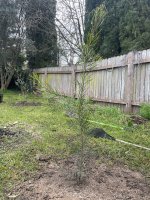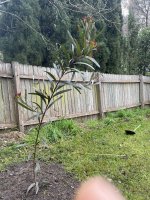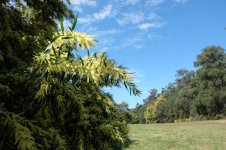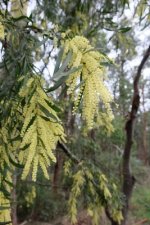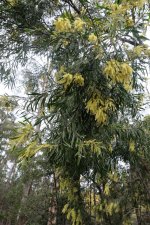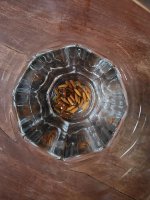-
Members of the previous forum can retrieve their temporary password here, (login and check your PM).
You are using an out of date browser. It may not display this or other websites correctly.
You should upgrade or use an alternative browser.
You should upgrade or use an alternative browser.
Botany The Acacia Grow Thread
- Thread starter acacian
- Start date
Growing logs with advice and results.
Migrated topic.
Animistic
Titanium Teammate
Tried 2 different methods of soaking for the phleb and the floribundas.
Phlebophylla I scarified then put in warm water
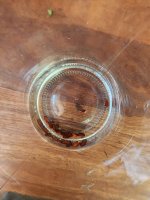
Floribunda I gave the hot water treatment to.
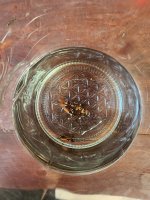
As you can see from the images, so far it seems the scarify has worked best. Which is what I thought but the floribunda seeds are so small it was difficult to get a good grip on them lol
Phlebophylla I scarified then put in warm water

Floribunda I gave the hot water treatment to.

As you can see from the images, so far it seems the scarify has worked best. Which is what I thought but the floribunda seeds are so small it was difficult to get a good grip on them lol
Nice @Animistic .. yeah I find with phleb hot water treatment works poorly. Scarification followed by cold water so far has worked best for me
Couple more plants in the ground.
Obtuse and another good form of flori. Hoping one day some of these plants will form hybrids!
Couple more plants in the ground.
Obtuse and another good form of flori. Hoping one day some of these plants will form hybrids!
Attachments
Animistic
Titanium Teammate
So cool to see them getting in the ground. I hope I'm settled enough in the next few years to plant a few acacia hedges  Floribunda/Obtusi hybirds would be really cool I reckon. You'd just need to save the pollen wouldn't you because they tend to flower at different ends of the year from my observations.
Floribunda/Obtusi hybirds would be really cool I reckon. You'd just need to save the pollen wouldn't you because they tend to flower at different ends of the year from my observations.
Yeah, I've found scarify and cold soak is generally the best germ technique for acacia in general. Seeing the difference here reminded me of what I already knew lol.
Yeah, I've found scarify and cold soak is generally the best germ technique for acacia in general. Seeing the difference here reminded me of what I already knew lol.
CheeseCat
Established member
@acacian, some nice reddening in both plants. The second floribunda is quite different to the first one you planted - less of a weeper, less dense and slightly smaller/narrower phyllodes by the looks of it. It'll be interesting to see how they both mature.
Do you loosen the root ball much when you plant them?
Do you loosen the root ball much when you plant them?
@CheeseCat Yeah that recent specimen is more erect atm.. partly because it grew without being interrupted by the frost. The weepier one got smashed by frost as a baby and so has grown more outwards than upwards. Both are very weepy when mature.. but yes, the weepier one is indeed from a more 'vertical weeper' (Not unlike "c") and does indeed have broader phyllodes than most floribunda I've seen. Its the one I call white willow. I just realised I said weepy/weeper way too many times. Hope your head isn't spinning after reading that. And no I don't loosen the root ball. I used to do this.. if you do it perfectly then it has benefits for sure... but there is a risk of damaging the roots - and with acacias this should be avoided at all cost.@acacian, some nice reddening in both plants. The second floribunda is quite different to the first one you planted - less of a weeper, less dense and slightly smaller/narrower phyllodes by the looks of it. It'll be interesting to see how they both mature.
Do you loosen the root ball much when you plant them?
Both very active though and really beautiful when they're older. Its very hard to get a read on how an acacia will look when its older at such a young age. Neither of these specimens in any way depict what they will look like when mature. My objective with floribunda is to cultivate the active form, and eventually test them and finally know whether flori's activity is genetic or environmental.. I suspect genetic.
@Animistic yeah I will have to save the flowers.
@_Trip_ .. when do we get to see these floribunda/phleb hybrid photos? I'm chomping at the bit here..
FIrst two photos are the mother plant of the more erect specimen I just put in the ground. The second are of the weepier one.
Attachments
Last edited:
Haha maybe in 3 weeks I'll be seeing my friend and taking photos. I hope he still has them he's been trimming down is collection of everything.
Yeah, @Animistic .. they are gorgeous. And I like how aptly the extract represents the feel of the tree. I don't like to say this or that tree is my favourite.. but floribunda must be pretty high up there. It has been such a journey with the species... back in the day wandering the neighbourhoods in Melbourne trying to identify them. Probably well over 20 failed extractions until I found the 'form' (or it found me rather). Feels great to have collected seed from those trees and now have them living on in my garden! 
They're just starting to bloom now.. they have a unique scent for Acacia.. almost like a sweet and a little citrus like.
I forgot to say, @CheeseCat your obtuse looks fantastic!

They're just starting to bloom now.. they have a unique scent for Acacia.. almost like a sweet and a little citrus like.
I forgot to say, @CheeseCat your obtuse looks fantastic!
Last edited:
CheeseCat
Established member
Cheers @acacian! That's really good to know about the root ball. I've always been undecided whether to intervene with the root ball or not, but I'll follow your wisdom. The broad leaf acuminata that I repotted (post #155) is really struggling now, curling tips and looking tired, probably way too much stress.
Can you elaborate a bit more? Curious to know the difference between genetic vs environmental activity. I would think they are both interrelated...My objective with floribunda is to cultivate the active form, and eventually test them and finally know whether flori's activity is genetic or environmental.. I suspect genetic.
CheeseCat
Established member
Beautiful @Animistic, I'm going to give it a go this weekend. How do you scarify the seeds? any recommendations? I think I'll try using a knife
This is my plan:
Hot Water Treatment:
Acacia floribunda - Scarify with knife + Hot water treatment 12hrs then straight to seed mix
Acacia mucronata - Scarify with knife + Hot water treatment 12hrs then straight to seed mix
Acacia oxycedrus - Scarify with knife + Hot water treatment 12hrs then straight to seed mix
Cold Water Treatment:
Acacia courtii - Scarify with knife + Cold water treatment 12hrs then straight to seed mix
Acacia phlebophila - Scarify with knife + Cold water treatment 12hrs then straight to seed mix
@acacian does this look about right?
This is my plan:
Hot Water Treatment:
Acacia floribunda - Scarify with knife + Hot water treatment 12hrs then straight to seed mix
Acacia mucronata - Scarify with knife + Hot water treatment 12hrs then straight to seed mix
Acacia oxycedrus - Scarify with knife + Hot water treatment 12hrs then straight to seed mix
Cold Water Treatment:
Acacia courtii - Scarify with knife + Cold water treatment 12hrs then straight to seed mix
Acacia phlebophila - Scarify with knife + Cold water treatment 12hrs then straight to seed mix
@acacian does this look about right?
Animistic
Titanium Teammate
@CheeseCat
I do it with sand paper or a nail file. I've used nail clippers in the past but I think it's too risky to damage it as opposed to scarify. Never tried using a knife. You just want to create a little knick. I'll try to do some more soon and send a photo.
Oh and FYI I've lost a whole bunch of seed going scarification and hot water before. I find cold water is all you need if it's scarified.
I do it with sand paper or a nail file. I've used nail clippers in the past but I think it's too risky to damage it as opposed to scarify. Never tried using a knife. You just want to create a little knick. I'll try to do some more soon and send a photo.
Oh and FYI I've lost a whole bunch of seed going scarification and hot water before. I find cold water is all you need if it's scarified.
Last edited:
Only time for short response atm.. I’d avoid scarifying with a knife as you risk breaking too far into the inner layer. I use a nail file.. doesn’t need much to be damaged enough to swell in water
CheeseCat
Established member
@Animistic @acacian phew, glad I ran it by you guys first! Ok, I'll use a nail file and stick to cold water for all my seeds. Really don't want to mess this one up!
If pre-scarifying, best avoid hot water.. hot water is only necessary for doing the actual scarifying. If you've already scarified then cold water is perfectly fine. And you'll notice they are much more vibrant looking as they activate. And yes floribunda seed is a little small for this method - but fortunately they germinate very well via hot water treatment. You could also place them between two pieces of very fine grit sandpaper. Avoid coarse stuff. It can break the seed. Happy growing guys.. I'm so excited spring is here! It gets a bit depressing during winter where I am. Feels great getting out in the garden again 
Give Acacia oxycedrus and phlebophylla time.. they can take months to start coming up if direct sown. I sowed 40 phleb and 30 oxycedrus seeds. They took about at least a couple months to start coming up and then continued to germinate eratically for another few months. They were only stopped short due to moving house anjd neglecting the trays.. I think about 30 of 40 came up of the phleb and I've no doubt more would have come up. Oxycedrus were very similar. If I start watering the flat trays daily I suspect I'll probably recover more in this warm weather. Same for oxycedrus.. these two species have thicker seed coats than most species.
Give Acacia oxycedrus and phlebophylla time.. they can take months to start coming up if direct sown. I sowed 40 phleb and 30 oxycedrus seeds. They took about at least a couple months to start coming up and then continued to germinate eratically for another few months. They were only stopped short due to moving house anjd neglecting the trays.. I think about 30 of 40 came up of the phleb and I've no doubt more would have come up. Oxycedrus were very similar. If I start watering the flat trays daily I suspect I'll probably recover more in this warm weather. Same for oxycedrus.. these two species have thicker seed coats than most species.
Last edited:
Sorry I missed your post on my phone @Animistic .. you summed all of that up already.
Animistic
Titanium Teammate
Sorry I missed your post on my phone @Animistic .. you summed all of that up already.
Oh, don't worry about that at all bro. I find multiple people sharing their experiences helps, even if they're similar. Great to know that my methods and experience line up with others tbh lol.

